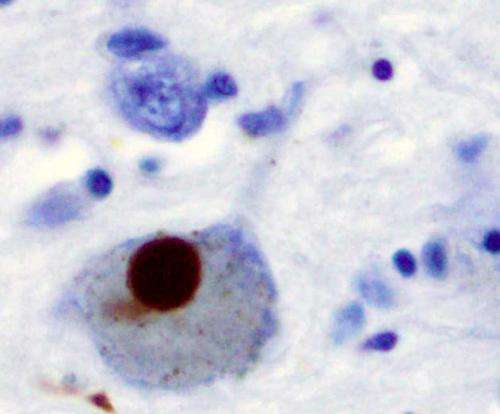Immunohistochemistry for alpha-synuclein showing positive staining (brown) of an intraneural Lewy-body in the Substantia nigra in Parkinson's disease. Credit: Wikipedia
Researchers at Karolinska Institutet in Sweden and the University of North Carolina in the USA have mapped out the cell types behind various brain disorders. The findings are published in Nature Genetics and offer a roadmap for the development of new therapies to target neurological and psychiatric disorders. One interesting finding was that cells from the gut's nervous system are involved in Parkinson's disease, indicating that the disease may start there.
The nervous system is composed of hundreds of different cell types with very different functions. It is vital to understand which cell types are affected in each disorder so as to understand the causes of the disorders and, ultimately, develop new treatments.
Researchers have now combined mice gene expression studies with human genetics to systematically map cell types underlying various brain disorders, including Parkinson's disease, a neurodegenerative disorder with cognitive and motor symptoms resulting from the loss of dopamine-producing cells in a specific region of the brain.
"As expected, we found that dopaminergic neurons were associated with Parkinson's disease. More surprisingly, we found that enteric neurons also seem to play an important role in the disorder, supporting the hypothesis that Parkinson's disease starts in the gut," says one of the study's main authors Patrick Sullivan, Professor at the Department of Medical Epidemiology and Biostatistics at Karolinska Institutet and Yeargan Distinguished Professor at the University of North Carolina.
When the researchers analysed differences in brain tissue from healthy individuals and people with Parkinson's disease at different stages of the disease, they made another unexpected discovery. A type of support cell in the brain called oligodendrocytes were found to be affected early on, suggesting that they play a key role in the early stages of the disease.
"The fact that the animal studies pointed us to oligodendrocytes and that we were then able to show that these cells were also affected in patients suggests that the results may have clinical implications," says Jens Hjerling-Leffler, research group leader at the Department of Medical Biochemistry and Biophysics at Karolinska Institutet and the other main author of the study.
The oligodendrocytes appear to be affected even before the loss of dopaminergic neurons.
"This makes them an attractive target for therapeutic interventions in Parkinson's disease," says Julien Bryois, researcher at the Department of Medical Epidemiology and Biostatistics at Karolinska Institutet and one of the first authors of the study.
More information: Bryois, J., Skene, N.G., Hansen, T.F. et al. Genetic identification of cell types underlying brain complex traits yields insights into the etiology of Parkinson's disease. Nat Genet (2020). doi.org/10.1038/s41588-020-0610-9
Journal information: Nature Genetics
Provided by Karolinska Institutet























